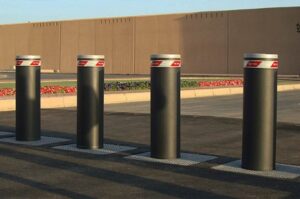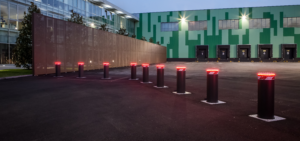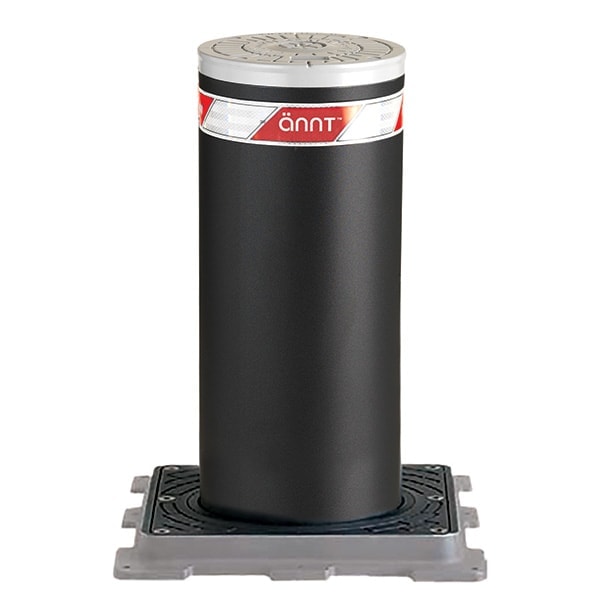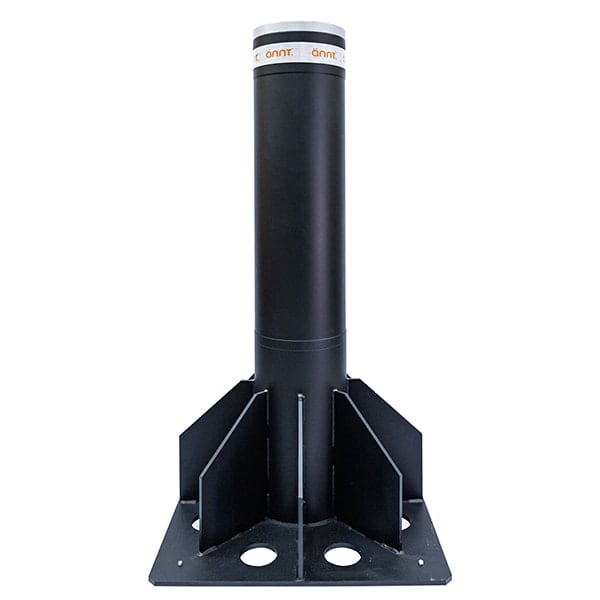
Automatic retractable bollards, also known as pop-up bollards or retractable security bollards, are innovative security devices designed to control vehicle access to specific areas. These sophisticated systems combine the robust protection of traditional fixed bollards with the flexibility of retractable mechanisms, offering a dynamic solution for modern security needs.
Retractable bollards are sturdy posts that can be raised or lowered into the ground automatically, creating a physical barrier when needed and allowing passage when retracted. Unlike their static counterparts, automatic bollards can be easily activated or deactivated, making them ideal for areas that require intermittent access control.
The key feature of these systems is their ability to respond quickly to changing security needs. Whether controlled remotely or triggered by various access control systems, automatic retractable bollards provide a seamless blend of security and convenience, making them increasingly popular in both public and private sectors.
How To Use Automatic Bollards?
Automatic retractable bollards find applications in a wide range of settings, each benefiting from their unique combination of security and accessibility. Some common uses include:
- Urban Planning and Traffic Management: Cities use retractable bollards to create pedestrian-only zones during specific times, enhancing safety and promoting a more walkable environment.
- High-Security Facilities: Government buildings, military installations, and other sensitive locations employ automatic bollards to regulate vehicle entry and protect against potential threats.
- Commercial Properties: Shopping centers, office complexes, and industrial parks utilize retractable bollard systems to manage parking access and secure loading docks.
- Residential Areas: Gated communities and high-end residences incorporate automatic bollards to control vehicle entry while maintaining an aesthetically pleasing appearance.
- Events and Temporary Installations: Pop-up bollards are ideal for creating secure perimeters around temporary events, allowing for quick setup and removal.
- Historic Sites and Tourist Attractions: Retractable bollards help preserve the visual appeal of heritage sites while providing necessary security measures.
- Airports and Transportation Hubs: These facilities use automatic bollards to manage traffic flow and enhance security at drop-off and pick-up points.
The versatility of automatic retractable bollards makes them an invaluable tool in modern security and access control strategies, adapting to the unique needs of each application.
Benefits of Implementing Retractable Bollard Systems
Adopting an automatic retractable bollard system offers numerous advantages over traditional security measures:
- Flexible Security: The ability to raise and lower bollards as needed provides adaptable security that can respond to changing circumstances or time-based requirements.
- Improved Aesthetics: When retracted, these bollards are virtually invisible, preserving the visual appeal of the surrounding area – a significant advantage over permanent barriers.
- Enhanced Safety: Automatic bollards can be integrated with emergency systems, allowing rapid access for first responders when necessary.
- Traffic Management: These systems excel at controlling vehicle flow, reducing congestion, and improving overall traffic management in busy areas.
- Cost-Effective: While the initial investment may be higher than static bollards, the long-term operational flexibility often results in cost savings and increased efficiency.
- Durability: High-quality retractable bollards are designed to withstand significant impact, offering robust protection against unauthorized vehicle entry.
- Integration Capabilities: Many automatic bollard systems can be seamlessly integrated with existing security infrastructure, including access control systems, CCTV, and alarm systems.
- Environmental Considerations: By allowing for the creation of vehicle-free zones, retractable bollards can contribute to reduced emissions and improved air quality in urban areas.
- Customization Options: Automatic bollards come in various designs and finishes, allowing them to complement the aesthetic of their surroundings.
How Automatic Retractable Bollards Work
Understanding the mechanics behind automatic retractable bollards helps you appreciate their effectiveness and reliability:
Basic Mechanism: At its core, a retractable bollard system consists of a sturdy post that can be raised from or lowered into an underground housing unit. This housing is typically made of steel and is installed below ground level.
Drive Systems: Automatic bollards use various drive mechanisms, including:
- Hydraulic: Utilizes fluid pressure to raise and lower the bollard
- Pneumatic: Uses compressed air for operation
- Electromechanical: Employs electric motors and gear systems
Control Systems: Automatic bollards can be activated through various means:
- Remote Controls: Allow authorized personnel to operate the bollards from a distance
- Access Control Integration: Can be linked with card readers, biometric systems, or license plate recognition technology
- Timers: For scheduled operation based on specific time periods
- Manual Override: For operation during power outages or emergencies
Safety Features: Most systems incorporate safety measures such as:
- Obstacle Detection: Prevents the bollard from rising if an object is detected in its path
- Emergency Fast Operation: Allows for rapid deployment in threat situations
- Fail-Safe or Fail-Secure Options: Determines whether bollards retract or remain raised during power failures
Weatherproofing: Quality automatic bollards are designed to operate in various weather conditions, with sealed components and drainage systems to prevent water ingress.
Visibility: Many bollards feature LED lighting or reflective strips for increased visibility, especially important in low-light conditions.
Understanding these operational aspects is crucial for facility managers and security professionals when considering the implementation of a retractable bollard system.
Types of Automatic Bollards and Choosing the Right System
When selecting an automatic retractable bollard system, it’s essential to consider the various types available and factor in specific needs and circumstances:
Hydraulic Bollards:
- Pros: High lifting capacity, smooth operation, suitable for frequent use
- Cons: May require more maintenance due to potential fluid leaks
Pneumatic Bollards:
- Pros: Fast operation, environmentally friendly (uses air), less affected by temperature changes
- Cons: May have limitations in extreme cold weather
Electromechanical Bollards:
- Pros: Lower maintenance, quieter operation, energy-efficient
- Cons: Generally slower operation compared to hydraulic systems
High-Security Bollards:
- Designed to withstand high-impact forces
- Often used in government or military installations
- May be crash-rated to specific standards (e.g., K4, K8, K12)
Shallow Mount Bollards:
- Ideal for areas with underground utilities or limited excavation depth
- Easier to install in existing infrastructure
Decorative Bollards:
- Combine security with aesthetic appeal
- Available in various finishes to complement architectural styles

When choosing the right automatic bollard system, consider the following factors:
- Security Level Required: Assess the potential threats and choose bollards rated appropriately.
- Frequency of Use: High-traffic areas may benefit from more robust systems designed for frequent cycling.
- Installation Environment: Consider ground conditions, available installation depth, and weather patterns.
- Integration Requirements: Ensure compatibility with existing security systems and access control methods.
- Aesthetic Considerations: Select bollards that complement the surrounding architecture and landscape.
- Budget: Balance initial costs with long-term operational and maintenance expenses.
- Compliance: Verify that the chosen system meets local regulations and standards.
- Maintenance and Support: Consider the availability of local technical support and spare parts.
By carefully evaluating these factors and understanding the different types of automatic retractable bollards available, decision-makers can select a system that provides optimal security, efficiency, and value for their specific needs.
In conclusion, automatic retractable bollards represent a significant advancement in perimeter security and access control. Their versatility, effectiveness, and ability to balance security with accessibility make them an excellent choice for a wide range of applications. As urban environments evolve and security challenges become more complex, the role of these innovative systems in protecting spaces and managing vehicle access is likely to grow even further.



